Types of Wooden Beams

Table of Contents
What is Wooden Beam?

A wood beam is structural support made from wood. They are most commonly used in wood frame structures like small houses, although they can be used in other types of construction as well. Beams are designed to resist bending when stressed by weight or forces like high winds.
Types of Wooden Beams
Here, the types of wooden beams are as follows.
1. Solid Wood Beams

Solid wood beams are constructed from a single piece of wood. They are, as the name indicates, quite strong. They have been used for ages to construct many types of buildings and constructions.
These beams have an obvious appeal due to their rough look, but they may be rather costly. Their substantial weight might also make installation more difficult.
2. Finger-Jointed Beams
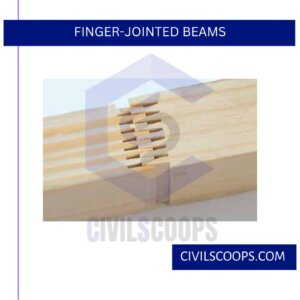
The finger-jointing technique is one method for making the most use of forest resources. It is a manufacturing technique that produces long beams by joining many short pieces of solid wood that have been purged of structural defects.
The wood pieces are constructed longitudinally and linked by finger joints to offer greater durability and mechanical strength.
Also Read: Difference Between Beam and Column | What Is Beam | What Is Column
3. Laminated Veneer Lumber (LVL) Beams

LVL is a composite made up of many layers of wood veneer and glue. LVL is not a new technology; the LVL process was used to make aero plane propellers during WWII. Since the 1970s, LVL has been utilized for beams and headers in building construction.
LVL referred to as Microlam, which is a proprietary term. LVL is also known as parallel-laminated veneer (PVL). Although the face-side look of LVL is similar to that of plywood, it is not plywood.
The grain of each veneer layer in LVL is engineered to run in the same direction (long) for consistent edge-load strength (on-edge, like a beam) or face-load strength (flat, as a plank).
When compared to a material of the same diameter that is “cross laminated” (cross-banded), such as plywood, this “parallel lamination” gives more uniformity and predictability. LVL is a great alternative for long-span load-bearing applications up to 80 feet due to its parallel lamination.
LVL is built to withstand warping, shrinking, slitting, bending, twisting, and crowning, much like other structural composite timber products. In other words, LVL and its SCL cousins provide consistent dimensional stability.
Pound for pound, an LVL beam has a higher load-bearing capability than the best solid-sawn timber of the same dimension.
4. Laminated-Strand Lumber (LSL)
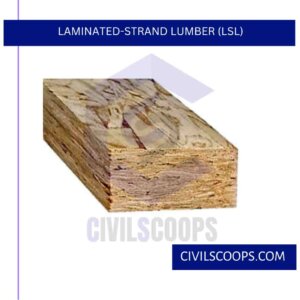
A laminated-strand timber beam is a factory-made, engineered composite beam. LSLs are commonly used as headers above windows and doors in wood frame walls.
LSL is made from tiny strands (up to 12 inches long) of hardwood that would not typically be deemed appropriate for structural uses. LSL has a similar face-side look to aligned strand board (OSB).
As with other engineered composite wood products, LSL is an alternative to flitch beams and steel lintels. LSL is also used as rim boards, intermediate span beams and purlins.
LSL offers the added benefit of good resistance to a lateral force such as the wind (winds up to 120 mph!). LSL can also be used as columns and wall studs. LSL wall studs can reach 30 feet.
5. Parallel-Strand Lumber (PSL)
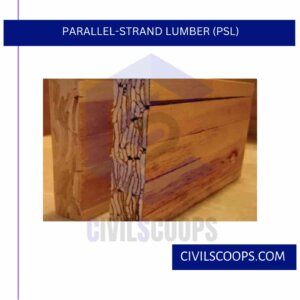
PSL, which is made from long, thin strands of wood fused together via a microwave technique, is dependably straight and robust, resisting shrinking, warping, and breaking.
PSL’s strength is comparable to that of LVL. Natural wood growth flaws such as knots are removed throughout the PSL production process.
PSL beams are available in widths of up to seven inches and depths of up to 18 inches. According to the manufacturers, a PSL beam may reach over 70 feet. PSL beams may be built up on the construction site to enhance strength and stiffness without increasing depth
6. Glued Laminated Timber (Glulam) Beams
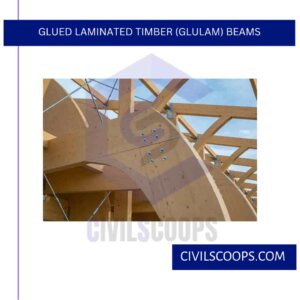
A typical Glulam girder is essentially a stack of bonded together two-by-four-inch dimensional lumber that is extremely strong, thus the full name: glue laminated lumber beam.
When nature and human engineering work together, tremendous strength and dependability are achieved. Pound for pound, a designed Glulam girder will always be stronger than nature’s most flawless, defect-free, sawn heavy timber.
A Glulam beam has the unusual property of being cambered; cambering is the upward pre-bending of a beam into a frown-shape so that the beam flattens when loaded rather than bending downward into a smile-shape when loaded.
A Glulam hybrid with laminated veneer lumber (LVL) at the bottom of the beam is available for further tension resistance.
Also Read: What Is Lintel Beam | Lintel Beam Size | 7 Types of Lintel Beam
7. Glued Solid Timber Beams
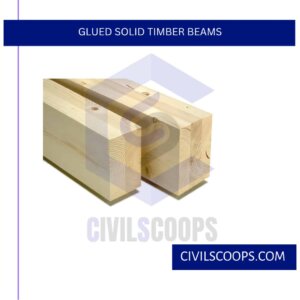
The thickness of the timber is the primary distinction between glued solid timber beams and glued laminated timber beams. The thickness of glued laminated timber slats is less than 45 mm, but the thickness of bonded solid timber boards is greater than 45 mm.
These beams outperform typical solid wood beams in terms of mechanical characteristics and durability. They are utilized in the construction of wood-frame homes and for exposed timber frames.
8. Prefabricated I-Beams
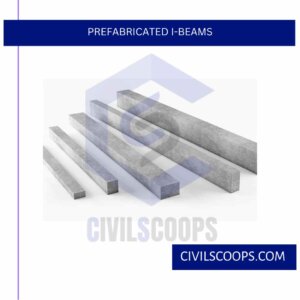
Prefabricated I-beams are load-bearing structural components that may be custom-built. The “I” design is made up of two horizontal components (the flanges) and a vertical segment (the web) between the flanges.
The flanges are often constructed of laminated veneer or laminated wood, whereas the web is typically made of oriented strand board (OSB).
These prefabricated I-beams are useful because, due to their small weight, they can be readily handled on building sites, even when they are quite long, without the need for expensive handling equipment. The “I” design produces a high level of flexural strength and stiffness.
9. Prefabricated Open-Web Joists
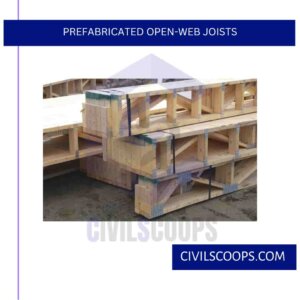
Open-web floor joists are constructed from two-dimensional timber flanges joined by wooden diagonals. This shape employs as little wood as possible while offering accurate, beneficial mechanical characteristics, notably in terms of flexibility.
Furthermore, the framework allows for the installation of construction components like as plumbing lines and ventilation ducts.
When used as floor joists, they are manufactured from sawn timber (23 or 24) laid flat, which offers structural sheathing support with a wide nailing surface.
10. Sawn Wood

Sawn (or milled) wood beams come in a wide range of species and grades. There are two primary types of wood among these: hardwood and softwood. Hardwoods are generally utilized for furniture, wall paneling, and flooring.
Softwoods are employed for ordinary building construction. Natural sawn lumber’s quality varies from tree to tree and even inside each tree since it is “designed” by nature.
The softwood Douglas fir is the strongest of the tree species utilized for sawn lumber. Grain direction is the most important aspect in determining the structural use of sawn wood. Compressive and tensile loads should ideally be applied parallel to the grain.
A given piece of wood can bear one-third greater force in compression than in tension when the load is applied parallel to the grain. In reality, the allowed compressive force perpendicular to the grain is one-fifth to one-half that of the allowable compressive force parallel to the grain.
11. Hand Hewn Wood Beams
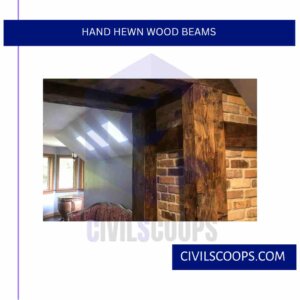
Hand Hewn Wood Beams are highly rustic, with obvious axe mark patterns. A broad axe, which has an angled blade on one side and a straight blade on the other, is commonly used on hand-hewn timbers.
These beams are frequently used to add character to an antique home, barn, or outdoor building. They are primarily utilized for nonstructural, ornamental reasons nowadays. Our experienced carpenters at Woodland Beam can recreate any appearance.
12. Wood Beams Wraps
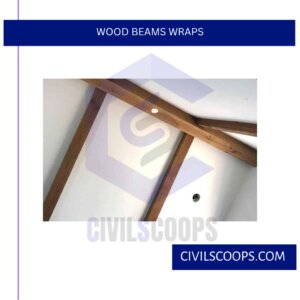
To give an unappealing wood beam a fresh appearance, wrap it within a box beam. Similarly, a Beam Wrap can be utilized to disguise an unsightly laminate or steel beam. Beam Wraps may be used to conceal virtually anything, including wiring, plumbing pipes (for more information on Whitton Plumbing), and duct work.
Because Wood Beam Wraps are indistinguishable from standard wood beams, they are essentially an appealing solution to conceal numerous unsightly structural components.
13. Wooden I-Beams

An I-beam is a type of light beam support that is made by gluing together hardwood flanges, fiberboard, and plywood webs. Building base floor-, intermediate floor-, and roof structures, as well as exterior wall frames, are examples of applications.
I-beams are ideally suited for constructions that require stiffness, heat insulation capacity, dimensional perfection, and cost effectiveness.
The beams are simple to work with using standard carpentry equipment, and holes in the web plates may be drilled for electrical and HVAC installations.
When modifying the beams, however, the manufacturer’s or structural designer’s recommendations must be followed. Because a flanged beam may accomplish the same load-bearing capacity with less material than glued laminated timber or sawn timber, the price is likewise competitive.
14. Conventional Wood Beams
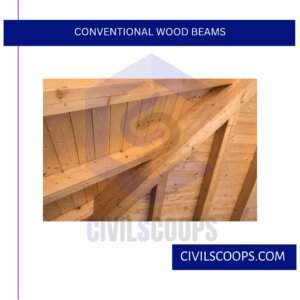
Traditional wood beams are quite heavy and hence difficult to deal with. A beam must be held in place at both ends by multiple people while a third person instals it. Some beams are heavy enough to need the use of lifting equipment.
Conventional beams, due to their great weight, may cause structural issues with the roof and ceiling. This frequently precludes the use of ordinary wood beams on existing dwellings without the assistance of a structural engineer to strengthen the roof.
Conventional wood beams are also prone to a variety of issues, including cracking, splitting, and twisting when the wood dries out. This can cause damage to the ceiling and walls. You may also have to deal with rotting or woodworms if you use these types of wood beams.
15. Custom Wood Beams

Custom Wood Beams are handcrafted from 1 inch stock, which means there is significantly less moisture in the wood, resulting in less twisting as it dries.
Furthermore, we may create Custom Wood Beams in whatever size we choose, whereas solid core beams are restricted to the size of the tree from which they are cut.
Furthermore, our expert carpenters have mastered a one-of-a-kind jointing method. We can exactly match the hewn and grain of existing beams, making our Custom Wood Beams indistinguishable from standard wood beams.
[su_box title=”FAQ” style=”default” box_color=”#333333″ title_color=”#FFFFFF” radius=”3″ class=”” id=””]
Types of Wooden Beams
- Solid wood beams. Solid wood beams are made of a single piece of wood.
- Finger-jointed beams.
- Laminated veneer lumber (LVL) beams.
- Glued laminated timber (glulam) beams.
- Glued solid timber beams.
- Prefabricated I-beams.
Wooden Beam
The term Wood Beam refers to a monolithic or composite piece of lumber engineered to span longer distances and support live, dead, wind, and seismic loads by transferring their weight to both ends and on down to a foundation.
Dark Wood Beams
“Dark wood beams” typically refer to wooden structural elements, such as beams or rafters, that are made from darker-toned wood and are often used in interior design and architecture to create a specific aesthetic. These beams are usually stained or finished with dark colors to achieve a rich, rustic, or vintage look in a room.
What Is a Wooden Beam?
Beams are large pieces of wood that are able to bear heavy loads. They can be made of solid wood or engineered wood.
Synthetic Wood Beams
These Synthetic Wood Beams are an indoor and outdoor cladding solution for walls and false ceilings. They are made up of a wood polymer composite which gives the material the look of wood and chromatic stability.
Retaining Wall Wood Beams
Retaining walls are relatively rigid walls used for supporting soil laterally so that it can be retained at different levels on the two sides. Retaining walls are structures designed to restrain soil to a slope that it would not naturally keep to (typically a steep, near-vertical or vertical slope).
What Are Faux Wood Beams Made Of?
Foam or Fake Wood Beams are most commonly made from high density polyurethane foam and are made in molds, or even extrusion forms. We’ve even seen beams (and the most inexpensive of flooring) that has a printed image of wood grain laminated to the face of the imitation material!
Composite Wood Beams
Composite wood-based beams and columns are intended to be used as a structural element for load- bearing applications in buildings and civil engineering structures, for example: construction members or. frame elements for walls, roofs, floors and trusses.
What Is the Strongest Wood Beam?
Power Beam® is the strongest engineered wood product (EWP) on the market with design values of 3000Fb – 2.1E – 300Fv.
Hollow Faux Wood Beams
New Real Wood Beams are made from real wood that is new wood which is then hand distressed for texture and color. The term “faux” refers only then to the fact that this is a hollow wood beam made to look like a solid wood beam.
Sandblasting Wood Beams
In older properties, grade II or I listed buildings the Oak beams and wood have been painted or varnished hiding the natural material. Our wood blasting techniques allow us to sandblast, internally or externally, to remove the old paint and varnish from all wood types (generally it’s old Oak).
Repairing Rotted Wood Beams
You can repair rotten wood by first removing the rotting from the original board or joists. You can then fill the surrounding area with a soft wood polyester filler or wood patch using a plastic putty knife. This material fills the area and cures to ensure strength and resilience.
Replacing Wood Beam with Steel
Ultimately, a beam in any material is a structural feature, not a decorative one, and if a wood beam is showing signs of sagging or other damage such as rot and woodworm, it may be time to replace it with a new steel beam instead.
Wooden Floor Beams
A Floor Joist may be defined as a timber beam that is perpendicular to the beam and parallel to the walls that is used for the purposes of providing a supportive framework for flooring.
How to Install Wood Beams on Ceiling?
First, locate and mark the position and direction of each ceiling joist around the edges of the ceiling. Then, avoiding ceiling fixtures, mark where the beams will be positioned. Keep their spacing even and ensure each beam will be attached to a joist. The beams can be installed across or along the ceiling joists.
How to Make Wood Beams?
Construct a simple 3-sided box from one 1×4 and two 1×6 whitewood boards using wood glue and a nail gun. Fill in nail holes with wood filler, then distress and stain the box for a rustic look. Repeat until you have enough boxes to span the length of your ceiling. These boxes will be your ceiling beams.
How to Make Wood Beams for Ceiling?
- Measure your ceiling and choose wood.
- Cut wood to desired lengths with circular saw.
- Assemble beams on the ground.
- Lift beams and attach to ceiling with screws.
- Sand, finish, and seal beams for a polished look.
How Much Do Wood Beams Cost?
Meranti Wood Beams
Price: 500.00 – 2000.00 INR (Approx.)
How to Install Wood Beams?
- Plan beam placement and measure.
- Locate joists or plan for wiring.
- Prep and finish beams.
- Lift beams, secure with screws or brackets.
- Check for level and alignment.
- Fill holes, touch up finish if needed.
How to Make Beams Look Like Wood?
- Prepare Surface: Choose a base material and sand it smooth.
- Base Coat: Paint with a base color resembling wood.
- Texture: Use a graining tool to create wood grain patterns.
- Highlight and Shadow: Apply lighter and darker shades for depth.
- Staining: Use water-based stains for realistic wood tones.
How to Install a Faux Wood Beam?
- Choose Location: Decide where to place the beam.
- Measure and Mark: Use a tape measure and level to mark positions.
- Prep Beam: Check openings, sand if necessary.
- Mounting Hardware: Attach L-brackets or anchors to ceiling.
- Position Beam: Lift beam onto brackets.
How Much Do Faux Wood Beams Cost?
Faux wood beam prices vary widely. Small foam beams might start at $50-$100, while larger, high-quality polyurethane beams can range from $150-$800 or more. Prices depend on size, material, and brand. Check local stores and online retailers for current prices.
How to Cover a Beam with Wood?
Nail your lumber in place.
Set them in place over the beam and use a nail gun or hammer and nails to hold it down. Ask someone to help you hold the lumber in place so it’s easier to nail down. Don’t forget to cover the sides as well. Put nails every 6 inches (15 cm) along each side of each board.
[/su_box]
[su_note note_color=”#F2F2F2 ” text_color=”#333333″ radius=”3″ class=”” id=””]
Like this post? Share it with your friends!
Suggested Read –
- What Is Louvered Door? | 10 Different Types of Louvered Doors Available in Market
- 15 Types of Porch Used for Home | What Is Porch | How to Infer What Porch You Need
- What Is Skillion Roof | Types of Skillion Roof | Uses of Skillion Roof | How to Build a Skillion Roof
- What Is Cedar Wood | Is Cedar a Hardwood | Uses of Cedar Wood | Types of Cedar | Red Cedar Wood | Facts About the Cedar Tree
- What Is Gypsum Boards? | Properties of Gypsum Board | Types of Gypsum Board | Advantages & Disadvantages of Gypsum Board
[/su_note]
Originally posted 2023-08-18 11:40:11.
